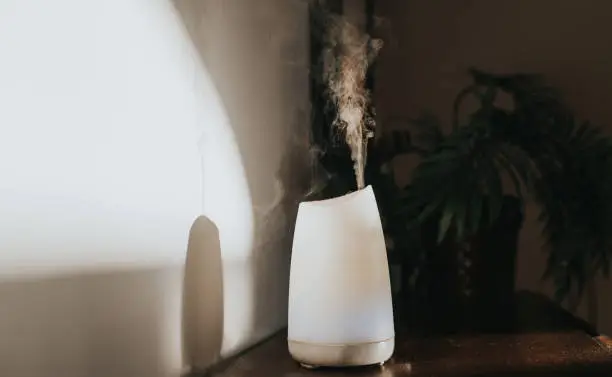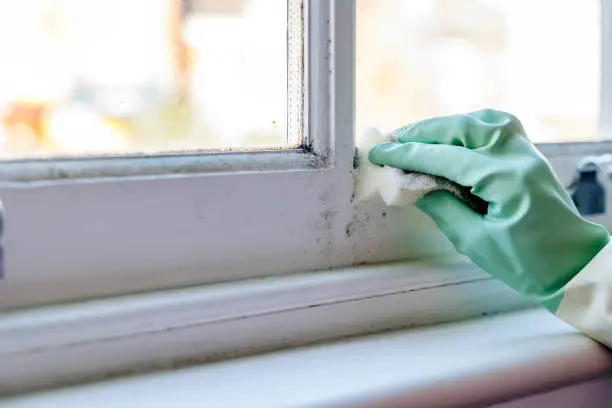
Table of Contents
Ever woken up with dry, itchy skin in the middle of winter? Or maybe you’ve noticed droplets of water clinging to your windows, even when it’s freezing cold outside. If any of this sounds familiar, there’s a good chance your home’s indoor humidity levels are out of balance. And while it might not seem like a big deal, getting this right is crucial—not just for your comfort, but for the health of your home and everyone living in it.
Let’s break down the top three signs that your indoor humidity level might be off and what you can do about it.
Sign #1: Windows That Weep
Picture this: it’s a crisp Canadian morning, and as you sip your coffee, you glance over at your windows, only to see them fogged up with condensation. Those beads of water might seem harmless, but they’re actually a red flag that your indoor air is holding onto too much moisture. In other words, you’re dealing with poor humidity.
When warm, humid air inside your home meets the cold glass of your windows, the moisture in the air condenses into water droplets. In moderation, this might not be a huge problem, but consistent condensation can lead to some serious issues. We’re talking mold growth, which loves to set up shop in damp places like your window frames. And once mold gets in, it’s tough to get out—not to mention the health problems it can cause, from allergies to respiratory issues.
But the problems don’t stop there. Excess moisture can also start to damage the structure of your home. Wooden window frames can swell, warp, and eventually rot, while the surrounding paint or wallpaper can start to peel and bubble. Before you know it, what seemed like a minor inconvenience has turned into a costly repair job.
So, what’s the fix? Proper ventilation is key. Ensuring that your home has adequate airflow can help reduce moisture buildup. If that’s not cutting it, you might need to consider a dehumidifier. It’s a simple solution, but one that can make a big difference in maintaining the balance in your home.
For those serious about tackling poor humidity, HVAC Service Solutions offers high-quality dehumidifiers that can help you keep your indoor humidity levels in check.
Sign #2: Your Skin’s as Dry as a Canadian Winter

Let’s face it, winter in Canada is no joke. The air outside gets bone-dry, and unfortunately, that dryness has a way of creeping indoors, especially if your home’s indoor humidity levels are too low. One of the first places you’ll feel it? Your skin.
If you’re constantly reaching for lotion because your skin feels tight, itchy, or even cracking, low humidity could be to blame. But it’s not just your skin that suffers. Dry indoor air can lead to a host of other unpleasant symptoms: chapped lips, scratchy throats, and irritated eyes. Even your nasal passages can dry out, which might not sound like a big deal, but it can make you more susceptible to colds and other respiratory issues.
This is particularly common in homes that rely on forced-air heating systems, which tend to dry out the air even further. You might think the solution is to just drink more water or use more moisturizer, but that’s only treating the symptoms, not the cause.
To really solve the problem, you need to add moisture back into the air. A whole-home humidifier is an excellent option here. Unlike portable units that only treat a single room, a whole-home system works with your existing HVAC setup to distribute humidity evenly throughout your home. The result? Not only does your skin feel better, but your overall comfort improves, and you might even notice a reduction in those pesky winter colds.
Sign #3: Wooden Floors That Crack Under Pressure
You might not think of wood as something that needs a lot of moisture, but when it comes to your hardwood floors, wooden furniture, or even those gorgeous wood trim details, humidity is actually a big deal.
Wood is a natural material, and it’s constantly expanding and contracting in response to the amount of moisture in the air. When your home’s indoor humidity level drops too low, wood starts to lose its moisture content, causing it to shrink. That’s when you might start noticing gaps between your floorboards, or worse, you might hear that telltale creak when you walk across the room. In more extreme cases, you could even see visible cracks or splits in your wooden furniture or flooring.
This doesn’t just mess with the aesthetic of your home—it can also affect the structural integrity of the wood. And unfortunately, once the damage is done, it’s not always reversible. Repairing or replacing wood floors and furniture can be incredibly costly and time-consuming.
So how do you prevent your wood from turning into a dried-out disaster? The answer is consistent humidity control. By maintaining a steady level of indoor humidity in your home, you can keep your wood looking great and functioning well. This might mean investing in a humidification system if your home tends to run dry, especially during the winter months.
Check out our previous article to find out how you can save up to $7800 on your new heat pump with Government Rebates Programs in Ontario.
https://thehvacservice.ca/government-heat-pump-rebates-in-ontario/
Ignoring These Signs? Here’s What Could Happen

Now, you might be thinking, “Sure, my skin’s a bit dry, and I’ve seen some condensation, but is it really that big of a deal?” The short answer? Yes.
Poor humidity can have a cascading effect on your home and your health. Beyond the immediate discomforts—dry skin, respiratory issues, mold—you’re looking at potentially major home repairs down the line. Rotting window frames, cracked floors, and peeling paint aren’t just unsightly; they’re expensive to fix. And let’s not forget the increased energy bills that often come with trying to compensate for an uncomfortable indoor environment.
But perhaps the biggest risk is the one to your health. Mold and mildew thrive in high humidity environments and can lead to chronic health problems, particularly for those with asthma or allergies. On the flip side, air that’s too dry can make you more prone to infections, as your body’s natural defenses are weakened.
What’s Next? Time to Take Action
If any of these signs sound familiar, it’s time to get proactive about your home’s indoor humidity levels. Start by checking your windows and wood surfaces for any signs of moisture or damage. Pay attention to how your skin and respiratory system feel, especially during the colder months.
From there, consider investing in a humidity control system. Whether you need a dehumidifier to take the edge off that sticky summer air or a humidifier to keep your home comfortable during the winter, the right solution can make a world of difference. Poor humidity doesn’t have to be a problem when you have the right tools at your disposal.
Managing your home’s indoor humidity isn’t just about preventing problems—it’s about creating a living environment that’s healthier, more comfortable, and more enjoyable all year round. HVAC Service Solutions is here to help you achieve the perfect indoor humidity balance with top-of-the-line humidifiers and dehumidifiers.
So, is your home’s indoor humidity level where it should be? If you’re not sure, don’t wait until the damage is done. Reach out to HVAC Service Solutions for a humidity assessment and take the first step toward a healthier home. Because when it comes to indoor comfort, balance is everything.
Frequent Asked Questions
What is the ideal indoor humidity level for a home?
The ideal indoor humidity level for most homes falls between 30% and 50%. This range provides a comfortable living environment while preventing issues like mold growth, dust mites, and excessive dryness. If humidity levels drop below 30%, you might experience dry skin, irritated respiratory passages, and even damage to wooden furniture and floors. On the other hand, levels above 50% can create conditions conducive to mold, mildew, and dust mites, which can harm your health and damage your home. Maintaining humidity within this range ensures a balanced atmosphere that protects both your health and your home’s structural integrity.
How can I measure the indoor humidity level in my home?
You can measure indoor humidity using a hygrometer, a small device that provides an accurate reading of the moisture content in the air. Hygrometers are available in digital and analog versions, and they’re generally affordable and easy to use. Place the hygrometer in a central location in your home for the most accurate reading, away from direct heat sources or windows. Monitoring humidity levels regularly helps you detect any fluctuations and take corrective action if necessary. Some smart thermostats also have built-in humidity sensors, providing continuous monitoring and easy access to humidity data.
What are the symptoms of low indoor humidity?
Low indoor humidity can cause a variety of uncomfortable symptoms, including dry, itchy skin, chapped lips, and irritated eyes. You might also experience respiratory issues, such as a dry throat, nosebleeds, or an increased susceptibility to colds and other infections. In addition to affecting your health, low humidity can also damage your home. Wooden floors, furniture, and musical instruments may crack or warp due to the lack of moisture in the air. Maintaining a proper humidity level can alleviate these symptoms and protect both your health and your home’s materials.
How does high humidity affect my home and health?
High indoor humidity can lead to several issues in your home and negatively impact your health. Excess moisture in the air promotes the growth of mold, mildew, and dust mites, which can trigger allergies, asthma, and other respiratory conditions. You might notice condensation on windows, walls, or pipes, which can eventually lead to peeling paint, rotting wood, and structural damage. High humidity can also make your home feel warmer, causing your air conditioning system to work harder and driving up energy costs. Managing humidity levels is crucial to preventing these problems and maintaining a healthy living environment.
Can I use a portable humidifier to control indoor humidity?
Yes, a portable humidifier can help control indoor humidity in specific areas of your home. These devices are particularly useful in bedrooms or living spaces where you spend a lot of time. However, while portable humidifiers are effective for small spaces, they may not be sufficient to maintain proper humidity levels throughout your entire home. For more comprehensive control, especially in larger homes, a whole-home humidifier integrated with your HVAC system is recommended. This type of system ensures even distribution of moisture across all rooms, providing consistent comfort and protection against humidity-related issues.
How often should I check my home's humidity levels?
It’s a good idea to check your home’s humidity levels regularly, especially during seasonal changes when indoor humidity can fluctuate significantly. In the winter, heating systems tend to dry out the air, while in the summer, humidity levels can spike due to warmer temperatures. Weekly checks with a hygrometer can help you stay on top of any changes and make adjustments as needed. If you notice persistent issues, such as condensation on windows or dry skin, more frequent monitoring may be necessary to ensure your indoor environment remains comfortable and safe.
What are some natural ways to increase indoor humidity?
If your home’s humidity level is too low, there are several natural methods you can try to increase moisture in the air. Placing bowls of water near heating vents or windows allows the water to evaporate slowly, adding humidity to the room. You can also grow houseplants, which release moisture through a process called transpiration. Another simple method is to leave the bathroom door open after taking a shower, allowing the steam to spread throughout your home. While these methods can help in small spaces, for consistent humidity control throughout your home, a humidifier is often more effective.
How can HVAC Service Solutions help me with my home's humidity issues?
HVAC Service Solutions offers a range of professional services to help you manage your home’s humidity levels effectively. We provide expert installation of whole-home humidifiers and dehumidifiers, which work with your existing HVAC system to maintain optimal indoor humidity. Our team can also perform humidity assessments to determine the current levels in your home and recommend the best solutions for your specific needs. Whether you’re dealing with dry air in the winter or excess moisture in the summer, our tailored solutions ensure your home remains comfortable and your indoor environment healthy.
What are the long-term effects of ignoring poor humidity in my home?
Ignoring poor humidity in your home can lead to a variety of long-term issues. Low humidity can cause chronic health problems, including respiratory issues and persistent dry skin. It can also damage wooden furniture, floors, and musical instruments, leading to costly repairs or replacements. High humidity, on the other hand, can encourage the growth of mold and mildew, which can deteriorate your home’s structure and compromise your indoor air quality. Over time, poor humidity management can result in increased energy bills as your HVAC system struggles to maintain a comfortable temperature.
How can I prevent humidity problems during seasonal changes?
To prevent humidity problems during seasonal changes, it’s important to be proactive. In winter, when indoor air tends to dry out, consider using a humidifier to add moisture back into the air. During the summer, when humidity levels rise, a dehumidifier can help keep moisture levels in check. Regular maintenance of your HVAC system is also crucial; clean filters and properly functioning equipment can improve air circulation and help manage humidity. Finally, sealing windows and doors can prevent outside air from affecting your indoor humidity levels, ensuring a stable and comfortable environment year-round.
Share



















